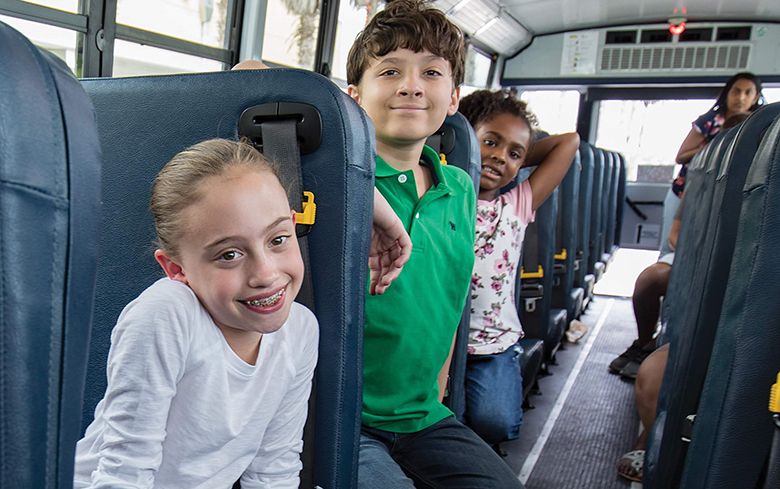
The Danger Zone risk to students
Students are most at risk not when they are riding the bus to school, but when they are loading and off-loading the bus. One-third of students who died in school transportation related crashes between 2006 and 2015, were killed while they were approaching or leaving the bus. This area is known as the school bus danger zone. A mix of inexperienced pedestrians, distracted drivers and bus blind spots make this area a high-risk zone and despite the industry’s best efforts, it remains high-risk today.
The 2018-19 school year saw 70 injuries and 17 fatalities related to school bus crossings.i The 2020 school year, noted for scaled down attendance levels due to the COVID-19 pandemic attributed four fatalities to school bus crossings.ii
Advanced technology has a critical role to play
Education, awareness, and accountability are part of ongoing efforts to address the risk to students outside the bus, but on their own are not effective at bringing real change. These approaches all rely on human attention. The statistics above show that this approach alone isn’t getting the desired results.
Experts suggest we are dealing with a combination of motorist distraction and disinterest in following rules and regulations. Today’s environments relentlessly challenge the focus and attention of every driver on the road with no signs of letting up. We should expect then to see an increase in these challenges and resulting repercussions.
Driving change
At Safe Fleet, we believe intelligence and advanced technology can bring together each of today’s safety tools – mirrors, video, and sensors – for a complete view of what’s going on around the bus. This gives the driver more than detection by offering a frame of reference. For example, a driver might get an alert for the right, rear of the bus, coupled with a spoken word alarm that indicates ‘child present.’ Adding intelligence to the safety mix brings clarity and the ability to respond quickly and confidently.
The absolute game-changer in this mix is technology that uses radar and predictive analytics to monitor oncoming vehicle traffic for probable stop arm violations. A district looking for comprehensive coverage in the Danger Zone would use this technology alongside stop arm camera systems, mirrors and crossing arms. Each tool plays a role in protecting the child, but when danger is detected by the advanced technology, the students at risk are notified to stay back. Unlike any other system, this advanced technology solution alerts students to take immediate and life-saving action. It helps keep students from entering into the Danger Zone in the first place.
School bus safety technology legislation
Bill 3684, Section 24110 mandates a review of illegal passing laws in each state and will identify best practices to address vehicles that pass stopped buses. The Bill also orders an education and awareness campaign and safety technology review. All danger zone technologies mentioned above will be an integral part of this review.
The ultimate goal is an environment where stop arm violations are not the norm. Until we reach this goal, intelligent technology and new ways of thinking can reduce risk to students in the Danger Zone almost as soon as these systems are implemented.
Why choose Safe Fleet?
Safe Fleet is committed to saving lives, preventing injuries and making fleets more productive. To this end, Safe Fleet has developed the Predictive Stop Arm® (PSA) a patented solution that uses radar technology and predictive analytics to monitor oncoming vehicle traffic, measuring vehicle speed and distance from a school bus. Analytics algorithms process data from radar sensors and determine whether a vehicle has sufficient time to slow down and stop. If the system perceives a student should not cross, the student will hear “Danger, Get Back,” emitted from speakers mounted outside the bus and the bus operator will receive a visual alert inside the bus.
Safe Fleet designs, manufactures, installs, and supports more safety products on school buses that any other provider in the industry (Think stop arms, crossing arms, mirrors, lighting and video systems.) And our focus on integrating those products using artificial intelligence and advanced analytics means we’re uniquely qualified to help you protect students inside and outside the bus.
By making School Bus fleets smarter, we make students safer.
Let’s create a safer environment together.
Read how Hopkins Public Schools earned a significant return on investment from the Predictive Stop Arm (PSA) within months of implementing. During an unloading procedure, a vehicle advanced in spite of the flashing lights and extended stop arm. The PSA alerted a student to stay back – away from danger.
Deirdre O’Brien is senior content specialist for Safe Fleet. Visit www.safefleet.net for more information.
ii https://www.ksde.org/Portals/0/School%20Bus/Surveys/NSB-LUS-20-21.pdf?ver=2021-12-01-120117-123


